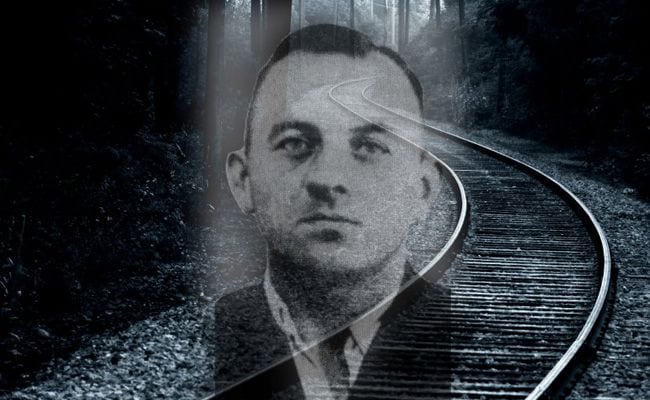
With a title as salacious as A Serial Killer in Nazi Berlin: The Chilling True Story of the S-Bahn Murderer, one might be tempted to approach Scott Andrew Selby’s book with a pinch of morbid skepticism. Yet what he delivers is a real life thriller that should be enough to satisfy both history buffs and crime novel lovers. Selby recounts the story of a seemingly normal railroad worker for whom night had acquired a completely different meaning than to the rest of the population in Berlin during the wartime.
As the lights of the city went out and a curfew was enforced to prevent planes from spotting targets during the night, Paul Ogorzow took a detour on his way home and spent his time terrorizing women who were making their way to their homes. First, he started by jumping out of bushes and scaring them by yelling obscenities. When this stopped bringing him any thrills, he attempted to cut them “like a drug addict who needs to use more and more to get the same high.” Selby further explains, “Ogorzow felt compelled to take things further with his victims. Eventually he escalated to sexually assaulting women and then, finally, to killing them.”
The author chronicles the need of the serial killer to outdo himself and paints a chilling portrait of what Berlin was like during the war. He explains how the country had gone from the decadence of Weimar, to living in a state of rigidness and false order, in which things were crumbling underneath the surface. The author paints a perfect example of this by pointing out the ironies held in Ogorzow’s preferred area of operation. The gardens where he first started attacking women were in fact examples of the best of Germany, and had been designed by the government as places where people without backyards could do some gardening. That Ogorzow turned them into his own playground of wickedness becomes a small allegory of the corruption that seeped the entire system.
Selby depicts Ogorzow’s crimes with clinical precision and knows how to make you cringe with pure horror. “As he pulled his knife out, he realized that Mrs. Nieswandt was screaming” he narrates, “despite his stabbing her neck, he’d done nothing to prevent her from yelling.” Selby attempts to identify exactly what is it that Ogorzow got out of the attacks, since his pleasure was limited, especially when he moved his criminal activities to the inside of a train known as the S-Bahn “as the interval between stations was short.” His knowledge of the train line allowed him to create his own kingdom of terrors, even if it denied him the pleasure of spending more time torturing his victims. Most chilling of all is how after everything he did, Ogorzow would simply throw the women off the train, clean himself up and go home to his family.
The book balances the gruesomeness of Ogorzow’s crimes, by telling the heroic story of Police Commissioner Wilhelm Karl Lüdtke, who ran the Serious Crimes Unit of Berlin’s Criminal Police force, better known as Kripo). As late as 1939, Lüdtke wasn’t even a member of the Nazi Party, which had taken power in 1933, and in the years in between, Lüdtke had continued voting for the German Democratic Party which among other things sought to protect the rights of Jews and other ethnic minorities. How did a man who had worked against the Nazis end up with one of the most important jobs in the Police Department?
A great student during his youth, Lüdtke was promoted to the Kripo at age 20, and eventually was chosen to run the political police in Frankfurt, where he eventually got in trouble with the Nazis for his political beliefs. He was forced to renounce all political activities when he used his connections to get the job in Berlin. Selby explains how Lüdtke was the one who realized there might be connections between the crimes being committed in the garden area where Ogorzow operated, suggesting that morally he felt that solving this crime would make up for his not doing anything more to stop the Nazis from their human rights violations.
Selby also explains how long it took the authorities to see the connections between the gruesome crimes against women that Ogorzow committed, in part because the system tried to deny any relation between these events. In their attempt to prove the world that Germany was at its best, Minister of Propaganda Goebbels’ officers would try to boycott connections attempted by investigators. Despite this, Lüdtke found a way to muster the resources necessary to catch the criminal and the last part of the book details a cat and mouse game in which the police would offer a reward, only to have Ogorzow realize he needed to take a break and return to his attacks when people forgot about him.
A Serial Killer in Nazi Berlin: The Chilling True Story of the S-Bahn Murderer is an expertly told detective story, in which the author presents a fascinating case without digesting the facts for his readers. He encourages readers to become involved and deduce the many sociopolitical ramifications of this case. As a chronicle of unknown German history, few recent books are as compelling.


![Call for Papers: All Things Reconsidered [MUSIC] May-August 2024](https://www.popmatters.com/wp-content/uploads/2024/04/all-things-reconsidered-call-music-may-2024-720x380.jpg)



